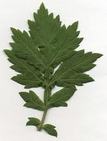Moxibustion

Moxibustion refers to the the burning of a dried spongy herb called moxa on or above the skin. Applications may also involve applying external heat sources to a topical moxa ointment. Moxa is the Japanese name for common mugwort (artemesia vulgaris), the herb traditionally used in Chinese medicine for these purposes. Mugwort has been used in a variety of folk medicines throughout the world for many centuries. The practice of moxibustion in Chinese medicine predates acupuncture and originated in the northern regions of China. It is such an integral part of the practice of acupuncture that the original Chinese character for acupuncture dually refers to acupuncture-moxibustion.
The purpose of moxibustion is to strengthen the Qi and blood and improve their flow throughout the body. The practice originated as a way of treating externally induced cold conditions. In ancient times, people were more exposed to the elements, as they spent long work days outside. The focus of Chinese medicine in those times tended to concentrate on the impact of so-called climatic conditions on internal health. Northern China is particularly cold, explaining the development of the use of moxibustion there. Exposure to cold and damp environments are thought to lodge the energy of cold and dampness deeply into the recesses of our bodies, weakening and stagnating the Qi and blood. When the Qi and blood stagnate, it creates dysfunction and pain. Moxibustion dispels cold and dampness. This restores the proper flow of Qi and blood, relieving painful conditions.
The purpose of moxibustion is to strengthen the Qi and blood and improve their flow throughout the body. The practice originated as a way of treating externally induced cold conditions. In ancient times, people were more exposed to the elements, as they spent long work days outside. The focus of Chinese medicine in those times tended to concentrate on the impact of so-called climatic conditions on internal health. Northern China is particularly cold, explaining the development of the use of moxibustion there. Exposure to cold and damp environments are thought to lodge the energy of cold and dampness deeply into the recesses of our bodies, weakening and stagnating the Qi and blood. When the Qi and blood stagnate, it creates dysfunction and pain. Moxibustion dispels cold and dampness. This restores the proper flow of Qi and blood, relieving painful conditions.
Ancient Practice - Modern Relevance
At first blush, the practice of moxibustion might seem a bit arcane, since we don't really live outside anymore in American culture. We may think that extreme cold exposure is improbable for most of us. The influences of cold and dampness are, however, still quite pervasive and more common than one might expect.
In fact, our modern conveniences have actually made summer a prime time for cold and damp invasions. Air conditioning is extremely cold and easily penetrates the body, especially when we are scantily clad and moist (perspiration or wet bathing suits). Another overlooked cause of cold exposure is surgeries. Operating rooms are kept very cold and your body is literally opened up to it. Then, of course, there are the obvious sources. Duck hunters standing waist deep in cold water. Too many hours spent shoveling snow. Standing or sitting for prolonged periods on cold surfaces, especially stone or concrete. Fashionable youth wearing abdomen exposing clothing in the dead of winter.
We can also generate our own internal sources of cold and damp because of an insufficiency of Qi. Wherever the cold and damp is generated from, these influences tend to lodge either in the meridian channels themselves or in cave-like spaces in the body - especially joints and hollow organs (e.g., bladder, uterus, bowels), leading to pain, degeneration and dysfunction. Given the nature of cold and damp influences, they can linger and drive themselves deeper into the body until dispelled. If not dispelled, these influences can literally stay in the body for a lifetime.
When Will Moxibustion Be Used?
Moxibustion will be used in your treatment strategy if there is an indication of a cold condition. Because cold tends to stagnate Qi and blood (much like cold temperatures freeze water), the primary indicator is some manifestation of pain. Common problems that often involve cold conditions include arthritis or other joint and muscle pain, chronic cystitis or UTIs, painful menstruation or ovulation, prostatitis, and idiopathic (unknown cause) infertility.